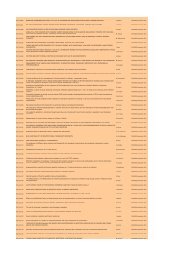Profilaksa DVT kod velikih ortopedskih operacija - Depol ...
Profilaksa DVT kod velikih ortopedskih operacija - Depol ...
Profilaksa DVT kod velikih ortopedskih operacija - Depol ...
You also want an ePaper? Increase the reach of your titles
YUMPU automatically turns print PDFs into web optimized ePapers that Google loves.
20 - 22 September 2012, Opatija, Croatia<br />
THE ROLE OF Nb IN OXIDIZED SURFACE OF A β-TiNb ALLOY ON<br />
ITS OSTEOINTEGRATION<br />
Marta Vandrovcova, Institute of Physiology AS CR, v.v.i, Prague, Czech Republic<br />
Ivan Jirka, J. Heyrovský Institute of Physical Chemistry AS CR, v.v.i., Prague, Czech Republic<br />
Otakar Frank, J. Heyrovský Institute of Physical Chemistry AS CR, v.v.i., Prague, Czech Republic<br />
Zdenek Tolde, Czech Technical University in Prague, Faculty of Mechanical Engineering, Prague, Czech<br />
Republic<br />
Thomas Luxbacher, Anton Paar GmbH, Graz, Austria<br />
Lucie Bacakova, Institute of Physiology AS CR, v.v.i , Prague, Czech Republic<br />
Vladimir Stary, Czech Technical University in Prague, Faculty of Mechanical Engineerin, Prague, Czech<br />
Republic<br />
The most commonly used Ti-based materials for bone implant fabrication are the alloys composed from titanium,<br />
aluminium and vanadium, particularly Ti6Al4V. These alloys fulfil many requirements for the implant material, i.e.<br />
they are characterized by their beneficial mechanical and chemical properties and high biocompatibility. However,<br />
substantial drawback of the TiAlV materials is the presence of small amounts of highly toxic Al and V oxide<br />
species in their surface region, or release of cytotoxic Al and V ions. Great attention thus has been paid to develop<br />
new materials which do not contain any toxic component. In this context, niobium is prospective as a non-toxic β<br />
stabilizing agent.<br />
In our study, the adhesion, growth and viability of human osteoblast-like MG63 cells on thermally oxidized surface<br />
of titanium (Ti600) and β-titanium-niobium (TiNb600) alloy were investigated. We also compared the influence<br />
-OH-group present on its surface (low concentration of OH-groups was observed after Piranha solution treatment).<br />
The role of sterilization in boiling water on the surface chemistry of the samples and the presence of Nb<br />
on the alloy surface on its interaction with cells was addressed. Sterilization of the samples caused extensive dehydroxylation<br />
of their surfaces. However, the overall acidity of the Ti600 and TiNb600 samples before and after<br />
sterilization is not affected by this treatment.<br />
The differences observed between Ti600 and TiNb600 samples which may participate in higher “osteointegration”<br />
can be summarized as follows: The surface of TiNb600 sample is more acidic. Moreover, the surface of TiNb600<br />
sample is negatively charged at physiological pH (6–7). This charge is, however, smaller than the charge on the<br />
surface of Ti600.<br />
The authors found that TiNb600 alloys showed improved colonization with MG63 cells. This was documented by<br />
significantly higher cell numbers on the TiNb600 (regardless of treatment by Piranha solution) compared with<br />
pure Ti600. In addition cell viability on day 7 after seeding was significantly higher on TiNb600 than on Ti600. Thus,<br />
niobium improves the mechanical properties of stainless steel, and it is suggested that addition of niobium to<br />
metallic alloys (especially to titanium alloys) could be useful for the fabrication of biomedical materials required<br />
definite mechanical features.<br />
Supported by the Grant Agency of the Czech Republic (grant No. P108/10/1858)<br />
Poster<br />
89




